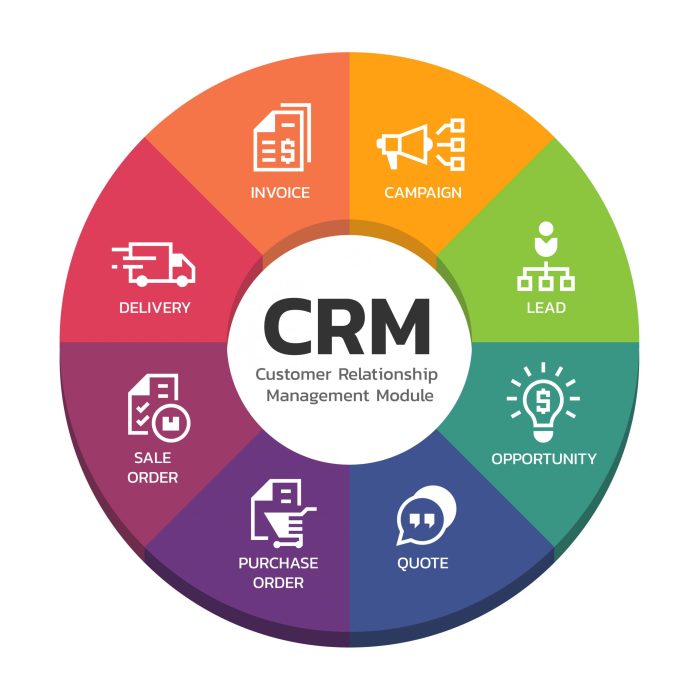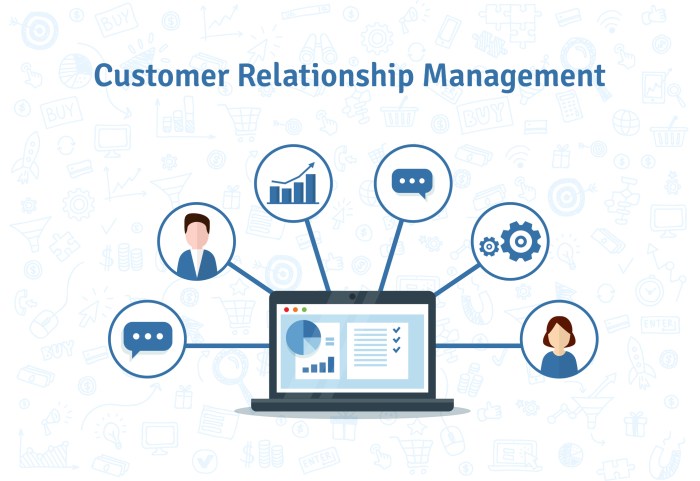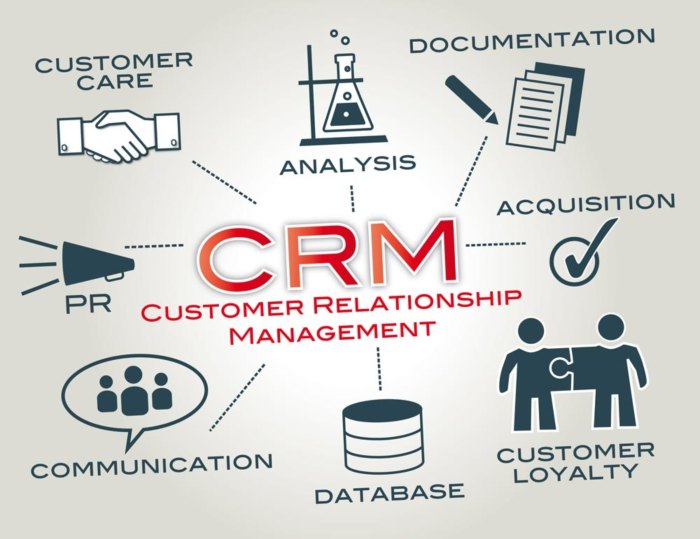CRM Contact Center: Unifying Customer Service and Sales
Originally posted 2024-10-12 17:20:00.
CRM Contact Center represents the convergence of href=”https://demographic.me/klaviyo-crm/” title=”Baca lebih lanjut tentang customer”>customer relationship management (CRM) and contact center technologies, creating a unified platform that empowers businesses to deliver exceptional customer experiences. This powerful integration streamlines communication, centralizes customer data, and provides a holistic view of each customer journey, enabling businesses to personalize interactions and cultivate lasting relationships.
Imagine a scenario where a customer contacts your business for a product inquiry. A CRM contact center seamlessly integrates with your CRM system, providing the agent with a comprehensive view of the customer’s past interactions, purchase history, and preferences. Armed with this information, the agent can offer personalized recommendations, address concerns effectively, and ensure a smooth and satisfying experience.
CRM Contact Center
A CRM contact center is a powerful combination of customer relationship management (CRM) and contact center technologies. It leverages the data and insights from CRM to enhance customer interactions and improve overall customer experience.
Synergy Between CRM and Contact Center Technologies, CRM CONTACT CENTER
A CRM contact center integrates CRM data, such as customer history, preferences, and interactions, with contact center functionalities, like call routing, queuing, and live chat. This integration enables agents to have a comprehensive view of each customer, providing personalized and efficient service.
Key Features and Functionalities
- Unified Customer View:CRM contact centers provide agents with a single, consolidated view of customer information, including past interactions, purchase history, and preferences. This enables personalized and context-aware interactions.
- Automated Routing and Queuing:Call routing and queuing systems use CRM data to direct calls to the most appropriate agents based on customer needs and agent expertise. This reduces wait times and improves customer satisfaction.
- Self-Service Options:CRM contact centers offer self-service options like FAQs, knowledge bases, and online chatbots, allowing customers to find solutions independently. This frees up agents to handle more complex inquiries.
- Data-Driven Insights:By analyzing CRM and contact center data, businesses can gain valuable insights into customer behavior, identify trends, and optimize operations. This data can be used to improve customer service, develop targeted marketing campaigns, and enhance product offerings.
- Customer Segmentation and Targeting:CRM contact centers enable businesses to segment customers based on their characteristics and behaviors, allowing for targeted communication and personalized service. This enhances customer engagement and loyalty.
Real-World Examples
- Amazon:Amazon’s CRM contact center integrates customer data from its e-commerce platform with its contact center, enabling agents to provide personalized recommendations and address customer concerns efficiently. This has helped Amazon achieve high customer satisfaction rates and drive repeat business.
- Netflix:Netflix uses CRM data to personalize its streaming recommendations and programs/” title=”Baca lebih lanjut tentang tailor”>tailor its marketing campaigns to individual customer preferences. This has contributed to Netflix’s massive growth and dominance in the streaming market.
- Apple:Apple’s CRM contact center integrates customer data from its Apple Store, online store, and other touchpoints. This allows agents to provide seamless and personalized support, enhancing customer satisfaction and loyalty.
Benefits of a CRM Contact Center
 benefits business key small” />
benefits business key small” />
A CRM contact center offers a range of benefits that can significantly improve customer satisfaction, operational efficiency, and overall business performance. By integrating customer relationship management (CRM) principles into contact center operations, businesses can gain valuable insights into customer behavior, streamline interactions, and create a more personalized and efficient experience.
Enhanced Customer Experience
A CRM contact center empowers businesses to provide a more personalized and consistent customer experience across all touchpoints.
- Personalized Interactions:CRM systems store comprehensive customer data, including purchase history, preferences, and past interactions. This allows agents to tailor their communication and provide relevant product recommendations, leading to a more personalized experience. For instance, a customer who has previously purchased a specific product might receive targeted offers or recommendations for related items.
- Seamless Omnichannel Experience:A CRM contact center enables businesses to manage interactions across multiple channels, such as phone, email, chat, and social media, from a single platform. This ensures a seamless customer experience, regardless of the channel they choose to engage with. For example, a customer who initiates a chat conversation can seamlessly transition to a phone call with the same agent without having to repeat their information.
- Proactive Customer Service:CRM systems can be used to identify potential customer issues or opportunities for improvement. For example, a customer who has recently made a purchase might receive a follow-up email or text message to ensure their satisfaction and address any potential concerns.
Improved Operational Efficiency
CRM contact centers streamline operations, reduce costs, and enhance agent productivity.
- Automated Processes:CRM systems can automate repetitive tasks, such as data entry, lead qualification, and appointment scheduling, freeing up agents to focus on more complex issues. For example, a CRM system can automatically capture customer information during a phone call, eliminating the need for manual data entry.
- Centralized Information:CRM systems provide a centralized repository for all customer data, ensuring that agents have access to the information they need to provide effective service. This eliminates the need to search through multiple systems or databases, saving time and reducing errors.
- Improved Agent Productivity:CRM systems provide agents with tools and resources to improve their efficiency, such as pre-populated scripts, knowledge base access, and real-time performance monitoring. For example, a CRM system can provide agents with access to frequently asked questions (FAQs) or product information, enabling them to quickly resolve customer inquiries.
Key Components of a CRM Contact Center
 pelanggan hubungan metode” title=”Manfaat crm adalah pelanggan hubungan metode” />
pelanggan hubungan metode” title=”Manfaat crm adalah pelanggan hubungan metode” />
A CRM contact center is a powerful tool for businesses seeking to enhance customer engagement and optimize operations. It leverages technology to centralize customer interactions, streamline processes, and provide a unified view of each customer. This holistic approach enables businesses to understand customer needs, personalize experiences, and drive customer loyalty.
Customer Relationship Management (CRM) System
A CRM system serves as the foundation of a CRM contact center. It stores and manages customer data, including contact information, purchase history, preferences, and interactions. This centralized repository provides a comprehensive view of each customer, enabling agents to understand their needs and tailor their responses accordingly.
A robust CRM contact center can streamline customer interactions and improve satisfaction. Integrating this system with a powerful ERP like DEACOM ERP can provide a comprehensive view of customer data, allowing agents to provide personalized and efficient support. This integration fosters seamless communication between sales, marketing, and customer service teams, enhancing overall business operations.
Contact Center Software
Contact center software empowers agents to handle customer interactions effectively. This software typically includes features such as call routing, call queuing, call recording, and interactive voice response (IVR). These features automate processes, improve call handling efficiency, and enhance the overall customer experience.
Unified Communications (UC)
Unified communications (UC) integrates various communication channels, such as phone, email, chat, and social media, into a single platform. This allows agents to interact with customers through their preferred channels, providing a seamless and convenient experience.
Reporting and Analytics
Reporting and analytics tools provide valuable insights into customer behavior and contact center performance. These tools enable businesses to track key metrics, identify areas for improvement, and optimize their operations.
Knowledge Base
A knowledge base serves as a repository of information that agents can access to answer customer inquiries quickly and accurately. This resource can include FAQs, product documentation, troubleshooting guides, and other relevant content.
Integration with Other Systems
To ensure a seamless customer experience, a CRM contact center should integrate with other systems, such as enterprise resource planning (ERP) systems, marketing automation platforms, and e-commerce platforms. This integration allows for real-time data sharing, enabling agents to access all relevant customer information.
Example of Integration
Imagine a customer contacting the contact center to inquire about a recent order. By integrating the CRM system with the e-commerce platform, the agent can access the customer’s order details, shipping information, and any previous interactions with the company. This allows the agent to provide accurate and personalized assistance.
A robust CRM contact center is essential for professional service firms to manage client interactions effectively. Integrating a CRM with a powerful ERP system can streamline operations and improve efficiency. Choosing the right ERP solution is crucial, and you can explore the top options for professional services by checking out this comprehensive guide on BEST ERP FOR PROFESSIONAL SERVICES.
By selecting the right ERP, you can ensure seamless data flow between your CRM contact center and other business processes, leading to a more cohesive and client-centric approach.
Implementation Considerations
Implementing a CRM contact center solution requires careful planning and consideration of various factors to ensure a successful integration and maximize its benefits.
Selecting the Right CRM Contact Center Solution
The first step in implementing a CRM contact center solution is to select the right one for your organization. This involves evaluating different options based on your specific needs, budget, and existing infrastructure.
- Scalability and Flexibility: The chosen solution should be able to scale with your business growth and adapt to evolving needs. Consider the number of agents, call volume, and future expansion plans.
- Integration with Existing Systems: Seamless integration with your existing CRM, ERP, and other business applications is crucial to avoid data silos and streamline workflows.
- Features and Functionality: Evaluate the features and functionality offered by different solutions, such as call routing, queuing, reporting, analytics, and automation capabilities.
- User Interface and Experience: A user-friendly interface and intuitive experience are essential for agent productivity and customer satisfaction.
- Security and Compliance: Data security and compliance with industry regulations are paramount. Ensure the solution meets your security standards and complies with relevant regulations.
- Cost and Return on Investment (ROI): Consider the total cost of ownership, including implementation, training, maintenance, and ongoing support. Evaluate the potential ROI based on improved efficiency, customer satisfaction, and revenue generation.
Best Practices for Successful Implementation
Implementing a CRM contact center solution effectively requires a structured approach and adherence to best practices.
A CRM contact center empowers businesses to manage customer interactions efficiently, from initial inquiries to post-sale support. Integrating this with a robust ERP system, like BUSINESS CENTRAL ERP , allows for a holistic view of customer data and operational processes, streamlining workflows and enhancing customer satisfaction.
- Define Clear Goals and Objectives: Clearly define your goals and objectives for implementing the solution, such as improving customer satisfaction, reducing response times, or increasing sales conversion rates.
- Involve Key Stakeholders: Engage key stakeholders from different departments, including IT, sales, marketing, and customer service, to ensure buy-in and collaboration throughout the implementation process.
- Develop a Comprehensive Implementation Plan: Create a detailed implementation plan that Artikels timelines, milestones, responsibilities, and resources required for each stage.
- Provide Adequate Training and Support: Invest in comprehensive training programs for agents and administrators to ensure they are proficient in using the solution and maximizing its benefits.
- Conduct Thorough Testing and Pilot Programs: Conduct thorough testing and pilot programs to identify and address any issues before full deployment. This will help ensure a smooth transition and minimize disruptions.
- Monitor and Evaluate Performance: Continuously monitor and evaluate the performance of the CRM contact center solution using key metrics such as customer satisfaction, agent productivity, and call handling times. Use the data to identify areas for improvement and optimize the solution over time.
A robust CRM contact center system needs a strong foundation, and that’s where a powerful ERP like NAVISION ERP SYSTEM comes in. By integrating with NAVISION, your contact center can access real-time customer data, streamline order processing, and provide a more personalized and efficient service experience.
Addressing Potential Challenges
Implementing a CRM contact center solution can present challenges, but by anticipating and addressing them proactively, organizations can mitigate risks and ensure a successful rollout.
- Resistance to Change: Some employees may resist adopting a new system. Address this by emphasizing the benefits of the solution, providing adequate training, and addressing concerns.
- Data Integration Issues: Integrating data from multiple systems can be complex. Ensure a smooth integration process by collaborating with IT teams and utilizing data mapping tools.
- Lack of User Adoption: Low user adoption can hinder the effectiveness of the solution. Encourage adoption through user-friendly interfaces, training, and ongoing support.
- Security Concerns: Address security concerns by implementing strong authentication measures, data encryption, and regular security audits.
- Cost Overruns: Stick to the budget by carefully planning, managing resources, and negotiating favorable contracts with vendors.
Future Trends in CRM Contact Centers

The CRM contact center landscape is constantly evolving, driven by technological advancements, changing customer expectations, and the need for businesses to enhance efficiency and customer satisfaction. Understanding emerging trends is crucial for organizations to stay ahead of the curve and optimize their contact center operations.
The Impact of Artificial Intelligence and Automation
AI and automation are transforming CRM contact centers by automating repetitive tasks, improving efficiency, and enhancing customer experiences. AI-powered chatbots and virtual assistants are increasingly used to handle routine inquiries, freeing up human agents to focus on more complex issues.
- AI-powered chatbotscan provide instant responses to frequently asked questions, resolving customer issues quickly and efficiently.
- Natural Language Processing (NLP)enables chatbots to understand and respond to customer queries in a natural, human-like manner.
- Machine Learning (ML)algorithms can analyze customer data to identify patterns and predict customer needs, enabling proactive support.
- Robotic Process Automation (RPA)automates repetitive tasks such as data entry and order processing, freeing up agents for more value-added activities.
The Role of Data Analytics in Optimizing Customer Interactions
Data analytics plays a vital role in understanding customer behavior, identifying trends, and personalizing interactions. By analyzing customer data, contact centers can gain insights into customer preferences, pain points, and buying patterns.
- Customer Relationship Management (CRM) systemscollect and analyze customer data to provide a holistic view of each customer.
- Predictive analyticscan identify customers at risk of churn or those likely to make a purchase, enabling proactive engagement.
- Real-time analyticsprovide insights into customer behavior during interactions, enabling agents to personalize their responses.
- Data visualization toolspresent data in an easily understandable format, enabling better decision-making.
The Rise of Omnichannel Customer Service
Customers expect seamless and consistent experiences across all channels, and omnichannel customer service is becoming increasingly important. CRM contact centers are evolving to support omnichannel interactions, ensuring a consistent experience regardless of the channel used.
CRM Contact Centers are essential for healthcare providers to manage patient interactions and streamline operations. Integrating a robust HEALTHCARE ERP system can further enhance the efficiency of these centers, allowing for seamless data exchange between departments and improving patient satisfaction by providing a unified view of their health information.
- Omnichannel CRM platformsprovide a unified view of customer interactions across all channels.
- Unified communicationsenable agents to handle customer interactions across multiple channels from a single interface.
- Contextualized customer dataensures that agents have access to all relevant information about a customer, regardless of the channel.
- Customer journey mappinghelps identify customer touchpoints and optimize the overall experience.
The Importance of Personalized Customer Experiences
Personalization is crucial for building strong customer relationships and driving loyalty. CRM contact centers are leveraging data analytics and AI to personalize interactions and create more meaningful experiences.
- Personalized recommendationsbased on customer preferences and past interactions.
- Targeted marketing campaignsbased on customer segments and behavior.
- Proactive customer supportbased on identified needs and potential issues.
- Customer journey optimizationbased on individual preferences and interactions.
Closure
By embracing CRM contact centers, businesses can transform their customer service operations, enhance customer satisfaction, and drive significant growth. As technology continues to evolve, the integration of artificial intelligence, automation, and data analytics will further revolutionize CRM contact centers, empowering businesses to personalize interactions, anticipate customer needs, and deliver exceptional experiences that foster loyalty and drive long-term success.
FAQs: CRM CONTACT CENTER
What are the key benefits of using a CRM contact center?
CRM contact centers offer numerous benefits, including improved customer satisfaction, increased operational efficiency, enhanced sales opportunities, and a more unified customer view.
How can I choose the right CRM contact center solution for my business?
When selecting a CRM contact center solution, consider your business needs, budget, integration capabilities, scalability, and the features and functionalities that align with your goals.
What are some examples of CRM contact center solutions?
Popular CRM contact center solutions include Zendesk, Salesforce Service Cloud, Freshdesk, and Microsoft Dynamics 365.